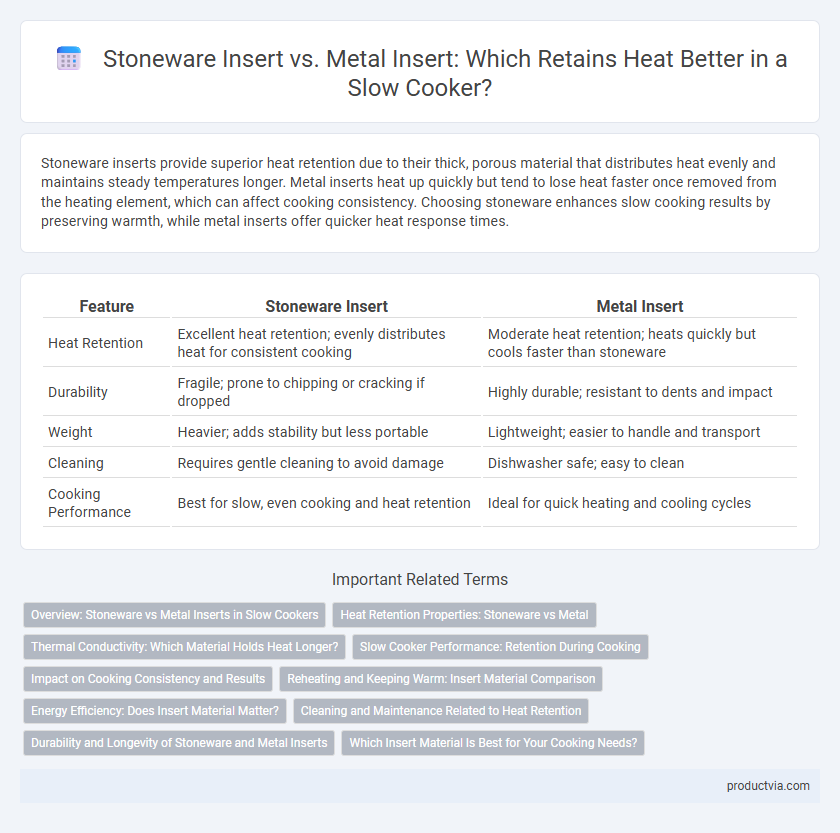Stoneware inserts provide superior heat retention due to their thick, porous material that distributes heat evenly and maintains steady temperatures longer. Metal inserts heat up quickly but tend to lose heat faster once removed from the heating element, which can affect cooking consistency. Choosing stoneware enhances slow cooking results by preserving warmth, while metal inserts offer quicker heat response times.
Table of Comparison
| Feature | Stoneware Insert | Metal Insert |
|---|---|---|
| Heat Retention | Excellent heat retention; evenly distributes heat for consistent cooking | Moderate heat retention; heats quickly but cools faster than stoneware |
| Durability | Fragile; prone to chipping or cracking if dropped | Highly durable; resistant to dents and impact |
| Weight | Heavier; adds stability but less portable | Lightweight; easier to handle and transport |
| Cleaning | Requires gentle cleaning to avoid damage | Dishwasher safe; easy to clean |
| Cooking Performance | Best for slow, even cooking and heat retention | Ideal for quick heating and cooling cycles |
Overview: Stoneware vs Metal Inserts in Slow Cookers
Stoneware inserts in slow cookers offer superior heat retention and even heat distribution, making them ideal for slow, consistent cooking. Metal inserts heat up quickly but tend to lose heat faster, which may cause temperature fluctuations during the cooking process. Stoneware's thermal mass helps maintain stable temperatures, enhancing flavor development and tenderness in dishes compared to metal inserts.
Heat Retention Properties: Stoneware vs Metal
Stoneware inserts excel in heat retention due to their dense and porous composition, allowing even and consistent heat distribution that keeps food warm longer. Metal inserts, while heating up quickly, tend to lose heat faster because metal is a good heat conductor but poor at retaining warmth over extended periods. Choosing stoneware over metal enhances slow cooker performance by maintaining stable cooking temperatures and better preserving heat after cooking.
Thermal Conductivity: Which Material Holds Heat Longer?
Stoneware inserts have lower thermal conductivity compared to metal inserts, allowing them to hold heat longer and provide more even, consistent cooking temperatures in slow cookers. Metal inserts heat up faster but lose heat more quickly once removed from the heat source, making stoneware superior for maintaining warmth over extended periods. This sustained heat retention in stoneware enhances slow-cooked dishes by ensuring thorough, even cooking without frequent reheating.
Slow Cooker Performance: Retention During Cooking
Stoneware inserts provide superior heat retention in slow cookers, offering consistent and even cooking temperatures that help maintain warmth for extended periods. Metal inserts, such as stainless steel or aluminum, heat up quickly but tend to lose heat faster, potentially causing less stable cooking performance. The denser composition of stoneware supports prolonged heat retention, enhancing slow cooker efficiency and improving meal texture and flavor through steady cooking.
Impact on Cooking Consistency and Results
Stoneware inserts offer superior heat retention compared to metal inserts, providing more even and stable cooking temperatures that prevent hot spots and ensure consistent results. Metal inserts heat up and cool down rapidly, which can cause fluctuations in cooking temperature and potentially lead to unevenly cooked dishes. The better thermal mass of stoneware supports gentle and uniform cooking, enhancing moisture retention and flavor development in slow-cooked meals.
Reheating and Keeping Warm: Insert Material Comparison
Stoneware inserts excel at retaining heat due to their dense ceramic composition, making them ideal for reheating and maintaining consistent warmth in slow cookers. Metal inserts, typically aluminum or stainless steel, heat up quickly but lose temperature faster, requiring more energy to keep food warm over extended periods. Choosing stoneware enhances thermal efficiency and preserves food temperature longer during slow cooker use.
Energy Efficiency: Does Insert Material Matter?
Stoneware inserts in slow cookers provide superior heat retention compared to metal inserts, which significantly enhances energy efficiency by maintaining a consistent temperature with less power consumption. Metal inserts heat up quickly but lose heat faster, causing the slow cooker to cycle on and off more frequently, increasing energy use. Choosing a slow cooker with a stoneware insert optimizes energy savings due to its ability to hold warmth longer and reduce the need for continuous heating.
Cleaning and Maintenance Related to Heat Retention
Stoneware inserts excel in heat retention due to their thick, porous material, ensuring food stays warm longer but require thorough hand washing to prevent residue buildup which can affect future heat distribution. Metal inserts heat up quickly and cool down fast, offering less heat retention but are dishwasher safe, simplifying cleaning and maintenance. Proper cleaning is essential for stoneware to maintain its heat-retaining properties, while metal inserts provide convenience at the cost of less consistent warmth.
Durability and Longevity of Stoneware and Metal Inserts
Stoneware inserts excel in heat retention due to their thick, porous material that distributes heat evenly, enhancing cooking consistency. Metal inserts heat up and cool down rapidly, offering less heat retention but greater durability against drops and scratches compared to fragile stoneware. While metal inserts generally have longer longevity with resistance to chipping and cracking, stoneware requires careful handling but maintains superior thermal performance for slow cooking.
Which Insert Material Is Best for Your Cooking Needs?
Stoneware inserts excel in heat retention, providing even cooking temperatures and maintaining warmth longer than metal inserts, making them ideal for slow-cooked stews and casseroles. Metal inserts, typically stainless steel or aluminum, heat up quickly and cool faster, offering better temperature control for recipes requiring occasional stirring or quick temperature adjustments. Choosing the best insert material depends on your cooking style: stoneware suits slow, steady heat applications, while metal inserts are preferable for versatility and faster heating.
Stoneware insert vs Metal insert for heat retention Infographic

 productvia.com
productvia.com